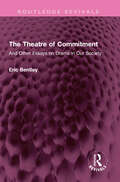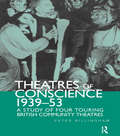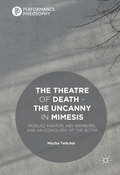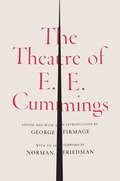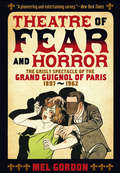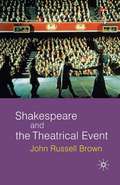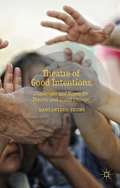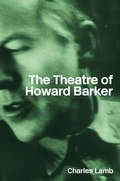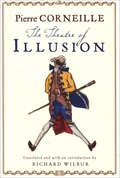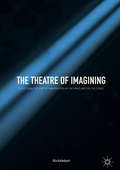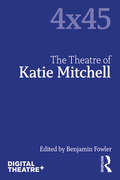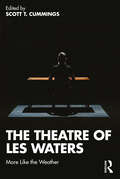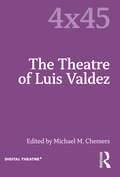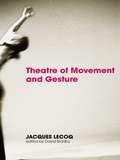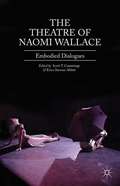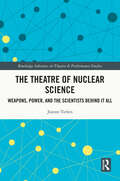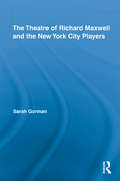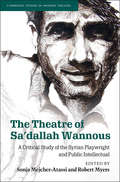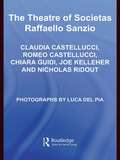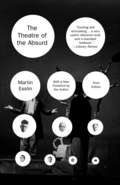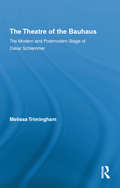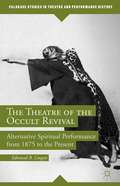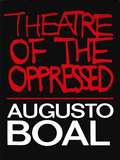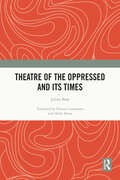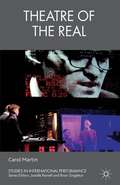- Table View
- List View
The Theatre of Commitment: And Other Essays on Drama in Our Society (Routledge Revivals)
by Eric BentleyFirst published in 1967 The Theatre of Commitment presents miscellaneous collection of seven essays written over fifteen years. Eric Bentley deals with themes like is the drama an extinct species; the American drama; what is theatre; the pro and con of political theatre; letter to a would-be playwright and the theatre of commitment. For most people, theatre of commitment is political theater, though Bentley indicates that the word commitment is broad enough to embrace the work of any serious writer even if the commitment is to non-commitment. This is an interesting read for students of theatre and performance studies.
Theatre of Conscience 1939-53: A Study of Four Touring British Community Theatres
by Peter BillinghamTheatres of Conscience offers an invaluable and essential insight into four touring British theatre companies whose work and contributions to post-war British theatre have largely gone unnoticed. Combining a rigorous scholarly evaluation of their work and their broadly ideological and ethical contribution to wider post-war developments in British theatre. Peter Billingham offers the reader a unique insight into four companies which, motivated by enthusiasm, principles and creative innovation, sought to take the theatre of conscience to theatre-less communities in wartime Britain and during the following decade. Contemporaries of - amongst others - Joan Littlewood's Theatre Workshop, the Pilgrim Players, the Adelphi Players, the Compass Players and the Century Theatre represent a significant but rather overlooked phase in the development of twentieth-century British theatre.
The Theatre of Death – The Uncanny in Mimesis
by Mischa TwitchinThis book is concerned with such questions asthe following: What is the life of the past in the present? How might "thetheatre of death" and "the uncanny in mimesis" allow us to conceive of theafterlife of a supposedly ephemeral art practice? How might a theatricaliconology engage with such fundamental social relations as those between theliving and the dead? Distinct from the dominant expectation that actors shouldappear life-like onstage, why is it that some theatre artists - from Craig toCastellucci - have conceived of the actor in the image of the dead? This bookexplores such questions through the implications of the twofold analogyproposed in its very title: as theatre is to the uncanny, so death is tomimesis; and as theatre is to mimesis, so death is to the uncanny. Walter Benjamin once observed that: "The point at issuein the theatre today can be more accurately defined in relation to the stagethan to the play. It concerns the filling-in of the orchestra pit. The abysswhich separates the actors from the audience like the dead from the living. . . " Ifthe relation between the living and the dead can be thought of in terms of ananalogy with ancient theatre, what about modernity?
The Theatre of E. E. Cummings
by E. E. Cummings Norman Friedman George James FirmageThe complete collection of E. E. Cummings's writing for the stage, from the most inventive poet of the twentieth century. The Theatre of E. E. Cummings collects in their entirety Cummings's long out-of-print theatrical works: the plays HIM (1927), Anthropos (1930), and Santa Claus (1946), and the ballet treatment Tom (1935). In HIM, a creatively blocked artist and his lover, Me, struggle to bridge the impasse in their relationship and in his art. In Anthropos, a Platonic parable, three "infrahumans" brainstorm slogans while a man sketches on a cave wall; and in Santa Claus, Death and Saint Nick exchange identities. Harriet Beecher Stowe's Uncle Tom's Cabin is reimagined as dance, transforming the novel into a symbolic attack against Evil itself. Cummings's prodigious creativity is on display in each of these works, which are ultimately about the place of the artist outside of society. "DON'T TRY TO UNDERSTAND IT, LET IT TRY TO UNDERSTAND YOU," Cummings famously wrote about his intentions for the stage. Thoughtful and witty, Cummings's dramas are an integral part of his canon.
Theatre of Fear & Horror: The Grisly Spectacle of the Grand Guignol of Paris, 1897-1962
by Mel Gordon"Bloodcurdling shrieks, fiendish schemes, deeds of darkness, mayhem and mutilation--we all have a rough idea of what Grand Guignol stands for. But until now it has been hard to find out much more about it than that. According to the American theater historian Mel Gordon, no major history of the theater so much as mentions it, although it is a form of entertainment that held its own on the Paris stage for more than half a century. But Mr. Gordon has made a thorough job of filling the gap."--John Gross, The New York TimesHere is the expanded edition of classic outré book, The Grand Guignol, first published in 1988 and now long out of print.Like the original anthology, it includes an illustrated introduction to the theater of Paris and abroad, a breakdown of its stage tricks, a summary of one hundred plots, extensive photo documentation, André de Lord's essay, "Fear in Literature," and two originally produced Grand Guignol scripts.The expanded edition also contains additional graphic and textual material including a color insert of Grand Guignol posters; the 1938 autobiographical account of Maxa, the company's leading female performer entitled "I Am the Maddest Woman in the World"; and the controversial playscript Orgy in the Lighthouse.
Theatre of Good Intentions
by John Russell BrownIn his latest book, John Russell Brown offers a new and revealing way of reading and studying Shakespeare's plays, focusing on what a play does for an audience, as well as what its text says. By considering the entire theatrical experience and not only what happens on stage, Brown takes his readers back to the major texts with a fuller understanding of their language, and an enhanced view of a play's theatrical potential. Chapters on theatre-going, playscripts, acting, parts to perform, interplay, stage space, off-stage space, and the use of time all bring recent developments in Theatre studies together with Shakespeare Studies. Every aspect of theatre-making comes into view as a dozen major plays are presented in the context for which they were written, making this an adventurous and eminently practical book for all students of Shakespeare.
Theatre of Good Intentions
by Dani Snyder-YoungTheatre of Good Intentions examines limitations of theatre in the creation of social and political change. This book looks at some of the reasons why achieving such goals is hard; examining what theatre can and can't do. It examines a range of applied and political theatre case studies, focusing on theatre's impact on participants and spectators.
The Theatre of Howard Barker
by Charles LambIn this second, fully revised edition of his acclaimed study of Barker's work, Charles Lamb sets out to make emotional sense of the characters and their interactions. This is a detailed exploration of the 'scene of seduction' - the challenge, the secret, the abject and the catastrophic, processes which dominate Barker's work. For Lamb, the power of Barker's plays is to be found in the exposure to the irrational and its promotion of a state of unknowing. This revised edition includes: * a new interview with Barker;* a revised introduction, * an updated bibliography * a full production chronology. For students of Barker and for actors and directors working with this unique material, Lamb's book is a vital and illuminating text.
The Theatre of Illusion
by Pierre CorneilleA magician conjures a dramatic adventure of romance and intrigue in this seventeenth-century French tragicomedy by the author of Le Cid.In Pierre Corneille’s sparkling play The Theatre of Illusion, magicians, lovers, and heroes prove that all the world truly is a stage. First performed in 1636, it was pioneering in its use of metatheatrical storytelling. It then vanished from the stage for the next three hundred years—to be revived in 1937 at the Comédie Française. Since then it has been widely considered, in Virginia Scott’s words, “Corneille’s baroque masterpiece.”Today this classic work is available in a translation from one of America’s finest poets and translators of French, Richard Wilbur. Widely praised for his translations of plays by Molière and Racine, Wilbur now turns his poetic grace to this celebration of the comedy of humanity and the magic of life.
The Theatre of Imagining: A Cultural History of Imagination in the Mind and on the Stage
by Ulla KallenbachThis book is the first comprehensive analysis of the fascinating and strikingly diverse history of imagination in the context of theatre and drama. Key questions that the book explores are: How do spectators engage with the drama in performance, and how does the historical context influence the dramaturgy of imagination? In addition to offering a study of the cultural history and theory of imagination in a European context including its philosophical, physiological, cultural and political implications, the book examines the cultural enactment of imagination in the drama text and offers practical strategies for analyzing the aesthetic practice of imagination in drama texts. It covers the early modern to the late modernist period and includes three in-depth case studies: William Shakespeare’s Macbeth (c.1606); Henrik Ibsen’s A Doll’s House (1879); and Eugène Ionesco’s The Killer (1957).
The Theatre of Katie Mitchell (4x45)
by Benjamin FowlerThis first volume in the 4x45 series investigates the work of theatre director Katie Mitchell. Pausing to reconsider a career in progress, it engages with some of Mitchell’s most recent work in the UK and Europe across theatre, opera, and Live Cinema. It also takes a longer view, considering the early turns that Mitchell took at the start of her career in the late 1980s. This volume gives full scope to the voice of the practitioner, alongside scholarly perspectives, in order to understand the work from within. Interviews with Mitchell’s collaborators get inside her process – and inside the thinking of key artists who help craft the distinctive visual, aesthetic and technological forms of Mitchell’s productions. Three major concerns criss-cross these contributions: the political implications of aesthetic form; the meaning of Mitchell’s interest in the radical project of early Naturalism; and the influence of Europe on Mitchell’s avant-garde experimentalism, which often draws on technology to open up new modes of perception and experience. An accessible and encompassing examination of one of Europe's most celebrated theatrical talents, 4x45 | The Theatre of Katie Mitchell is a unique resource for scholars,students and practitioners of Theatre Studies, Performance and Directing.
The Theatre of Les Waters: More Like the Weather
by Scott T. CummingsThe Theatre of Les Waters: More Like the Weather combines original writings from Les Waters with short essays by a wide range of his collaborators, creating a personal and multi-faceted portrait of an influential director, revered mentor, and inspirational theatre artist. The book begins with a critical introduction of Waters’s work, followed by essays written by a wide range of Waters's collaborators over the past four decades. These essays are framed by shorter pieces of writing by Waters himself: reflections, inspirations, observations, and personal anecdotes. At the heart of this book lies the notion that the director’s central position in theatrical production is defined by collaboration and that a study of directing should take into account how a director works with playwrights, designers, actors, stage managers, and dramaturgs to turn artistic vision into concrete reality on stage. An insightful resource for early career or student directors in theatre programs, The Theatre of Les Waters sheds light on the art of theatre directing by exploring the work of a major theatre artist whose accomplished career sits at the heart of American theatre in the 21st century. Drawing on aspects of memoir, case study, interview, miscellany, biography, and criticism, this is also an enlightening read for anyone with an interest in how theatre artists bring their creative vision to life.
The Theatre of Luis Valdez (4x45)
by Michael M. ChemersThe Theatre of Luis Valdez focuses on the life and work of American playwright and director Luis Valdez, probably best known for his landmark 1979 play Zoot Suit – the first play by a Latinx playwright to appear on Broadway – and founder of El Teatro Campesino, the oldest surviving community theatre in the United States. Built around first-hand discussions of Valdez’s work, this collection gives an in-depth understanding of where ‘the godfather of Chicano theatre’ fits in the grand scheme of American drama and performance. Collaborators Edward James Olmos and Alma Martinez talk about working with Valdez and El Teatro Campesino; scholar Leticia Garcia interviews Jorge Huerta, the leading authority on Chicanx and Latinx theatre on the impact of Valdez work; and Luis Valdez himself contributes a lecture on all aspects of his craft from political resistance and the migrant experience to actor training and dramatic form. A concise and accessible study, 4x45 || Luis Valdez is the go-to resource for scholars, students and theatre practitioners looking for an introduction to this seminal figure in modern American performance.
Theatre of Movement and Gesture
by Jacques LecoqPublished in France in 1987, this is the book in which Lecoq first set out his philosophy of human movement, and the way it takes expressive form in a wide range of different performance traditions. He traces the history of pantomime, sets out his definition of the components of the art of mime, and discusses the explosion of physical theatre in the second half of the twentieth century. Interviews with major theatre practitioners Ariane Mnouchkine and Jean-Louis Barrault by Jean Perret, together with chapters by Perret on Étienne Decroux and Marcel Marceau, fill out the historical material written by Lecoq, and a final section by Alain Gautré celebrates the many physical theatre practitioners working in the 1980s.
The Theatre Of Naomi Wallace
by Scott T. Cummings Erica Stevens AbbittNaomi Wallace, an American playwright based in Britain, is one of the more original and provocative voices in contemporary theatre. Her poetic, erotically-charged, and politically engaged plays have been seen in London's West End, off-Broadway, at the Com#65533;die-Fran#65533;aise, in regional and provincial theaters, and on college campuses around the world. Known for their intimate, sensual encounters examining the relationship between identity and power, Wallace's works have attracted a wide range of theatre practitioners, including such important directors as Dominic Dromgoole, Ron Daniels, Jo Bonney, and Kwame Kwei-Armah. Drawing on scholars, activists, historians, and theatre artists in the United States, Canada, Britain, and the Middle East, this anthology of essays presents a comprehensive overview of Wallace's body of work that will be of use to theatre practitioners, students, scholars, and educators alike.
The Theatre of Nuclear Science: Weapons, Power, and the Scientists Behind it All (Routledge Advances in Theatre & Performance Studies)
by Jeanne P TiehenThe Theatre of Nuclear Science theoretically explores theatrical representations of nuclear science to reconsider a science that can have consequences beyond imagination. Focusing on a series of nuclear science plays that span the twentieth and twenty-first centuries, and including performances of nuclear science in museums, film, and media, Jeanne Tiehen argues why theatre and its unique qualities can offer important perspectives on this imperative topic. This book will be of great interest to students and scholars of theatre, politics, and literature.
The Theatre of Richard Maxwell and the New York City Players (Routledge Advances in Theatre & Performance Studies)
by Sarah GormanThe theatre of Richard Maxwell and the New York City Players has received significant international recognition over the past ten years. The company has received three OBIEs, for House (1999), Drummer Wanted (2002) and Good Samaritans (2005). Maxwell received a Guggenheim Fellowship in 2010 and has been commissioned by venues in the United States, the United Kingdom, Germany, Austria, the Netherlands, France, Belgium and Ireland. Although his productions generate a plethora of reviews, there is a deficit of material providing a critical and sustained engagement with his work. The aim of this book is to provide a critical survey of Maxwell’s work since 1992, including his early participation in Cook County Theater Department. Touching upon the acting, production and rehearsal processes of NYC Player’s work, and Maxwell's representations of space, community, race, and gender, this volume provides scholars with an important overview of a key figure in contemporary drama.
The Theatre of Sa'dallah Wannous: A Critical Study of the Syrian Playwright and Public Intellectual (Cambridge Studies in Modern Theatre)
by Sonja Mejcher-Atassi Robert MyersThe Theatre of Sa'dallah Wannous is the first book in English to provide a clear sense of the significance and complexity of Wannous' life and work. It is unique in bringing cross-disciplinary scholarship on Wannous together and aligning it with cultural practice and memory by including contributions from leading academics as well as renowned cultural figures from the Arab world. This volume should be of interest to literary and theatre studies scholars, cultural historians, theatre practitioners and anyone who cares about contemporary theatre, Syria and the Arab world. Collectively, the contributions demonstrate the role of cultural production - especially dramatic literature - in providing a portrait of and shaping a culture in the throes of profound transformation.
The Theatre of Societas Raffaello Sanzio
by Nicholas Ridout Joe Kelleher Claudia Castellucci Chiara Guidi Romeo CastellucciThe Theatre of Socìetas Raffaello Sanzio chronicles four years in the life of an extraordinary Italian theatre company whose work is widely recognized as some of the most exciting theatre currently being made in Europe. In the first English-language book to document their work, company founders, Claudia Castellucci, Romeo Castellucci and Chiara Guidi, discuss their approach to theatre making with Joe Kelleher and Nicholas Ridout. At the centre of the book is a detailed exploration of the company's eleven episode cycle of tragic theatre, Tragedia Endogonida (2002–2004,) including: production notes and extensive correspondence giving insights into the creative process essays by and conversations with company members alongside critical responses by their two co-authors seventy-two photographs of the company's work. This is a significant collection of theoretical and practical reflections on the subject of theatre in the twenty-first century, and an indispensible written and visual document of the company's work.
The Theatre of the Absurd
by Martin EsslinIn 1953, Samuel Beckett’sWaiting for Godotpremiered at a tiny avant-garde theatre in Paris; within five years, it had been translated into more than twenty languages and seen by more than a million spectators. Its startling popularity marked the emergence of a new type of theatre whose proponents—Beckett, Ionesco, Genet, Pinter, and others—shattered dramatic conventions and paid scant attention to psychological realism, while highlighting their characters’ inability to understand one another. In 1961, Martin Esslin gave a name to the phenomenon in his groundbreaking study of these playwrights who dramatized the absurdity at the core of the human condition. Over four decades after its initial publication, Esslin’s landmark book has lost none of its freshness. The questions these dramatists raise about the struggle for meaning in a purposeless world are still as incisive and necessary today as they were when Beckett’s tramps first waited beneath a dying tree on a lonely country road for a mysterious benefactor who would never show. Authoritative, engaging, and eminently readable,The Theatre of the Absurdis nothing short of a classic: vital reading for anyone with an interest in the theatre.
The Theatre of the Bauhaus: The Modern and Postmodern Stage of Oskar Schlemmer (Routledge Advances in Theatre & Performance Studies #16)
by Melissa TriminghamFocusing on the work of painter, choreographer and scenic designer Oskar Schlemmer, the "Master Magician" and leader of the Theatre Workshop, this book explains this "theatre of high modernism" and its historical role in design and performance studies; further, it connects the Bauhaus exploration of space with contemporary stages and contemporary ethics, aesthetics and society. The idea of "theatre of space" is used to highlight twentieth-century practitioners who privilege the visual, aural, and plastic qualities of the stage above character, narrative and, themes (for example Schlemmer himself, Robert Wilson, Tadeusz Kantor, Robert Lepage). This impressive volume will be of use to students and academics involved in the areas of twentieth-century performance, the history of performance art, the history of avant-garde theatre, modern German theatre, and Weimar-era performance.
The Theatre Of The Occult Revival
by Edmund B. LinganBased on field research and archival study, this book offers an in-depth exploration of the religious foundations, political and social significance, and aesthetic aspects of the theatre created by several of the most influential leaders of the Occult Revival: Katherine Tingley, Rudolf Steiner, Marie Steiner-von Sivers, Aleister Crowley, Alexander Mathews, and Gerald Gardner. The Occult Revival was an international surge of interest in the supernatural, magic, and Eastern mysticism that thrived in Europe and the United States between the late nineteenth-century and the mid-twentieth-century. By studying the theatre that was developed in affiliation with occult movements, this book shows how theatre contributed to the complication and fragmentation of Western religious culture during the turn-of-the-century Occult Revival and how theatre continues to play a part in the development of occult rituals and beliefs.
Theatre of the Oppressed
by Augusto Boal Charles A. McbrideThe innovative Brazilian playwright, director and international lecturer explicates Aristotle's poetics and the philosophies of Machiavelli, Hegel and Brecht to determine the extent to which their chief components--imitation, catharsis and, ultimately, audience control--serve up to support the status quo of a society rather than facilitate change.
Theatre of the Oppressed and its Times
by Julian BoalPolitical theatre, like any kind of political action, can only be judged in relation to the political moment in which it tries to intervene. Theatre of the Oppressed (TO) was created to fight against dictatorship and an extremely centralized conception of politics. How does it function now, in a time of social media and so-called participatory democracies? Providing an in-depth account of the political and cultural context in which TO emerged, this book asks: How do contemporary understandings of concepts like oppression, representation, participation, and emancipation shape TO today? Highlighting the pitfalls of reducing oppression to one-to-one relationships, the book proposes a version of Forum Theatre dramaturgy that portrays oppression as a defining structure of societies. The author also shares specific examples of movements and other organizations that use Theatre of the Oppressed to construct themselves. Theatre of the Oppressed and Its Times is an essential text for practitioners and scholars of TO, applied theatre practitioners, students, and anyone interested in how theatre can concretely assist in the transformation of the world.
Theatre of the Real
by Carol MartinAt an unparalleled time of the construction of reality across the fields of the science and humanities on a variety of platforms, theatre and performance participates in the current obsession with the problems and possibilities of the epistemologies of the real by using and revising the conventions of dramatic writing and performance to create and recreate personal, national, historical, and virtual realities. Theatre of the Real examines a wide range of international theatre and performance that claims a special relationship to contemporary reality in order to theorize how theatre and performance participates in how we come to know, experience, and understand the important events of our personal, social and political lives. The wide range of works discussed include Kamp and History of the World - Part Eleven by Hotel Modern, Is. Man by Adelheid Roosen, I am My Own Wife by Doug Wright, Southern Exposure by JoAnne Akalaitis, My Name is Rachel Corrie by Alan Rickman and Katherine Viner and Via Dolorosa by David Hare.
